
Kuala Lumpur, officially the Federal Territory of Kuala Lumpur and colloquially referred to as KL, is a federal territory and the capital city of Malaysia. It is one of the fastest-growing cities in Asia and the largest city in Malaysia, covering an area of 243 km2 (94 sq mi) with a census population of 2,163,000 as of 2022. Greater Kuala Lumpur, also known as the Klang Valley, is an urban agglomeration of 7.564 million people as of 2018. It is among the fastest growing metropolitan regions in Southeast Asia, both in population and economic development.
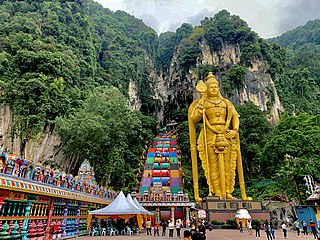
Batu Caves is a mogote that has a series of caves and cave temples in Gombak, Selangor, Malaysia. It takes its name from the Malay word batu, meaning 'rock'. The cave complex is one of the most popular Hindu shrines outside India, and is dedicated to Murugan. It is the focal point of the Tamil festival of Thaipusam in Malaysia.
Keretapi Tanah Melayu Berhad (KTMB) or Malayan Railways Limited, colloquially referred to simply as KTM, is the main rail operator in Peninsular Malaysia. The railway system dates back to the British colonial era, when it was first built to transport tin. Previously known as the Federated Malay States Railways (FMSR) and the Malayan Railway Administration (MRA), Keretapi Tanah Melayu acquired its current name in 1962. The organisation was corporatised in 1992, but remains wholly owned by the Malaysian government.

The spider family Liphistiidae, recognized by Tamerlan Thorell in 1869, when broadly circumscribed to include two subfamilies, comprises 8 genera and about 100 species of medium-sized spiders from Southeast Asia, China, and Japan. They are among the most basal living spiders, belonging to the suborder Mesothelae. In Japan, the Kimura spider is well known. In 2022, it was proposed to re-accept the subfamily Heptathelinae as the family Heptathelidae. As of December 2023, this proposal was accepted by the World Spider Catalog. In this circumscription, the family Liphistiidae has only one genus, Liphistius.

Ipoh is the capital city of the Malaysian state of Perak. Located by the Kinta River, it is nearly 200 km (120 mi) north of Kuala Lumpur and 150 km (93 mi) southeast of George Town in neighbouring Penang. As of the 2020 census Ipoh had a population of 759,952, making it the eighth-largest city in Malaysia by population.

KTM Komuter is a commuter rail system in Malaysia operated by Keretapi Tanah Melayu (KTM). It was introduced in 1995 to provide local rail services in Kuala Lumpur and the surrounding Klang Valley suburban areas. Services were later expanded to other parts of Malaysia with the introduction of the Northern and Southern sectors.
Federal Highway is a Malaysian controlled-access highway connecting the capital city of Kuala Lumpur, and Klang, Selangor. The highway starts from Seputeh in Kuala Lumpur to Klang, Selangor. It is the busiest highway in Klang Valley during rush hour from/to Kuala Lumpur. The Federal Highway is coded as Federal Route 2.

The Gombak District is an administrative district located in the state of Selangor, Malaysia. The district was created on February 1, 1974, the same day when Kuala Lumpur was declared a Federal Territory. Until 1997, Rawang was the district capital; the capital has been moved to Bandar Baru Selayang. Gombak borders Kuala Lumpur to the southeast and the Genting Highlands to the east. Both Gombak and Kuala Lumpur, along with some other districts in Selangor, are situated within the Klang Valley. Other localities that are situated in Gombak district include Batu Arang, Kuang, Rawang, Kundang, Gombak Town, Selayang, Batu Caves and Hulu Kelang.

Kuala Lumpur Middle Ring Road 2, Federal Route 28, is a ring road built by the Malaysian Public Works Department (JKR) to connect neighborhoods near the boundary of Federal Territory of Kuala Lumpur and Selangor. Altogether, the 65.0 km (40.4 mi) of the entire system consists of Federal Route 28, Damansara–Puchong Expressway Damansara–Puchong Expressway and Shah Alam Expressway Shah Alam Expressway. However, the Kuala Lumpur Middle Ring Road 2 is generally referred to as Route 28 since Route 28 occupies about two-thirds of the system.

Kepong is a town in northern Kuala Lumpur, Malaysia. The name is a Malay word meaning "Enclose" or "Surround", as the town is surrounded by a mountain range.

Barychelidae, also known as brushed trapdoor spiders, is a spider family with about 300 species in 39 genera.

Rail transport in Malaysia consists of heavy rail, light rapid transit (LRT), mass rapid transit (MRT), monorails, airport rail links and a funicular railway line. Heavy rail is mostly used for intercity services and freight transport as well as some urban public transport, while rapid transit rails are used for intracity urban public transport in the capital city of Kuala Lumpur and the surrounding Klang Valley region. There are two airport rail link systems linking Kuala Lumpur with the Kuala Lumpur International Airport and Sultan Abdul Aziz Shah Airport. The longest monorail line in the country is also used for public transport in Kuala Lumpur, while the only funicular railway line is available in Penang.
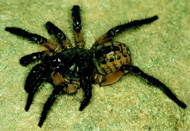
Liphistius is a genus of basal trapdoor spiders in the family Liphistiidae. They are found in Japan, China, and Southeast Asia.

Templer Park is a forest reserve in Rawang, Gombak District, Selangor, Malaysia. It is 1,214 hectares in size and it was named in honour of Sir Gerald Templer, a British High Commissioner in Malaya. "On 8 September 1954, His Highness the Sultan of Selangor, the late Sultan Hishamuddin Alam Shah declared that Templer’s Park was 'dedicated by Selangor to serve as a refuge and a sanctuary for wildlife and a meeting-place for all who love and respect the beauty of nature'. The following year the government gazetted the area as “a Botanical Garden and Public Park” under the land enactment ".
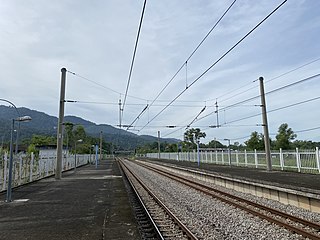
Railway electrification in Malaysia is a relatively recent development of rail transport in Malaysia. While the first railway in the country dates back to 1885, it was not until 3 August 1995 that the first electrified railway service, KTM Komuter, began operations.

Greater Kuala Lumpur is the geographical term that determines the boundaries of metropolitan Kuala Lumpur in Malaysia. Though similar to the term "Klang Valley", there remains a variation between the two. It is similar to Greater London and Greater Toronto. The metropolitan area covers 5,194.72 square km of land.
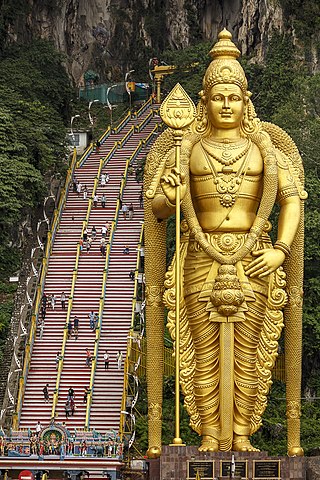
Batu Caves Murugan Statue, is the tallest statue in Malaysia and one of the tallest statue in the world at 42.7 metres (140 ft) in height.
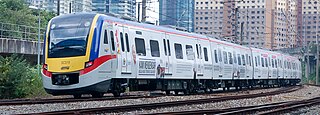
The KTM Batu Caves–Pulau Sebang Line, formerly known as the Seremban Line is one of the three KTM Komuter Central Sector lines provided by Keretapi Tanah Melayu. Its electric trains run between Batu Caves and Pulau Sebang/Tampin. Prior to 15 December 2015, the northern terminus of this line was Rawang.

The Euctenizidae are a family of mygalomorph spiders. They are now considered to be more closely related to Idiopidae.

















